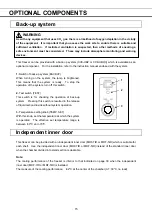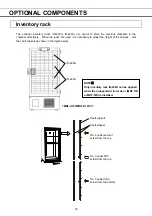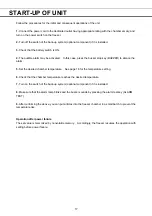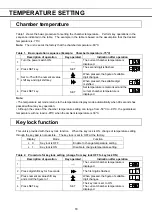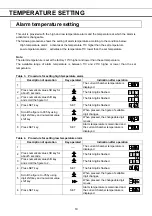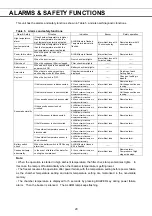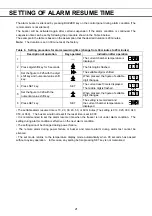
6
CAUTIONS FOR USAGE
●
When the first start-up or start-up after no use of long period, the warning device may not operate,
because its Ni-MH battery has completely discharged. This does not denote a malfunction. In this
case, continue to operate the unit for about 3 hours. To fully recharge the completely discharged battery,
the unit has to be operated for about 2 days.
●
In the case of high ambient temperature, the cabinet front may heat up after the freezer starts to
operate first. However, this does not denote a malfunction. It is due to the hot gas piped around the
unit frame to prevent condensation around the cabinet.
●
Cool down the freezer chamber sufficiently before storing materials and put the materials in a small
batch to reduce the temperature rise.
●
The digital thermometer of this ultra-low temperature freezer is designed to display the temperature of
the center part of the freezing compartment. The thermometer sometimes displays a temperature a little
bit higher than the actual temperature of the center part depending on the amount or arrangement of
stored items.
●
An access port to take out the measuring cable in the case is provided on the back wall and right
bottom of the freezer. Be sure to replace the cap and thermal insulation after taking out of the cable, or
the chamber temperature cannot complete down, and frost may accumulate outside the port
surroundings.
●
Always open and close the door gently. Rough operation may lead fall down of stocked items,
incomplete closing, or damage of door gasket.
●
Clean the unit with a diluted neutral dishwashing detergent. (Undiluted detergent can damage the
plastic components. For the dilution, refer to the instruction of the detergent.) After the cleaning with
the diluted detergent, always wipe it off with a wet cloth. Then wipe off the cabinet or accessories with a
dry cloth. Do not use brushes, acids, thinners, powdered soap or hot water for cleaning the freezer.
Polishing powders or hot water can deteriorate the painted surfaces or cause deformation, discoloration
or degeneration of plastic or rubber components. Be especially careful not to wipe plastic or rubber
parts with volatile solvents such as benzine.
●
The frost will be built up on the chamber wall and inner door during operation. Use a scraper
provided with the freezer or equivalent tool to remove the frost. The inner door is hard to be opened
when a large amount of frost is built up on it. In this case, remove the frost by detaching the inner door
as shown in page 27.
●
There are pipelines for cooling behind the walls. Do not defrost inside walls using a knife, ice pick, or
screw driver. Be careful not to damage the walls or to make a hole on the walls as this could cause a
failure of the freezer. Also, take care not to drop a heavy item or anything with sharp edge on the
bottom of the chamber.

















